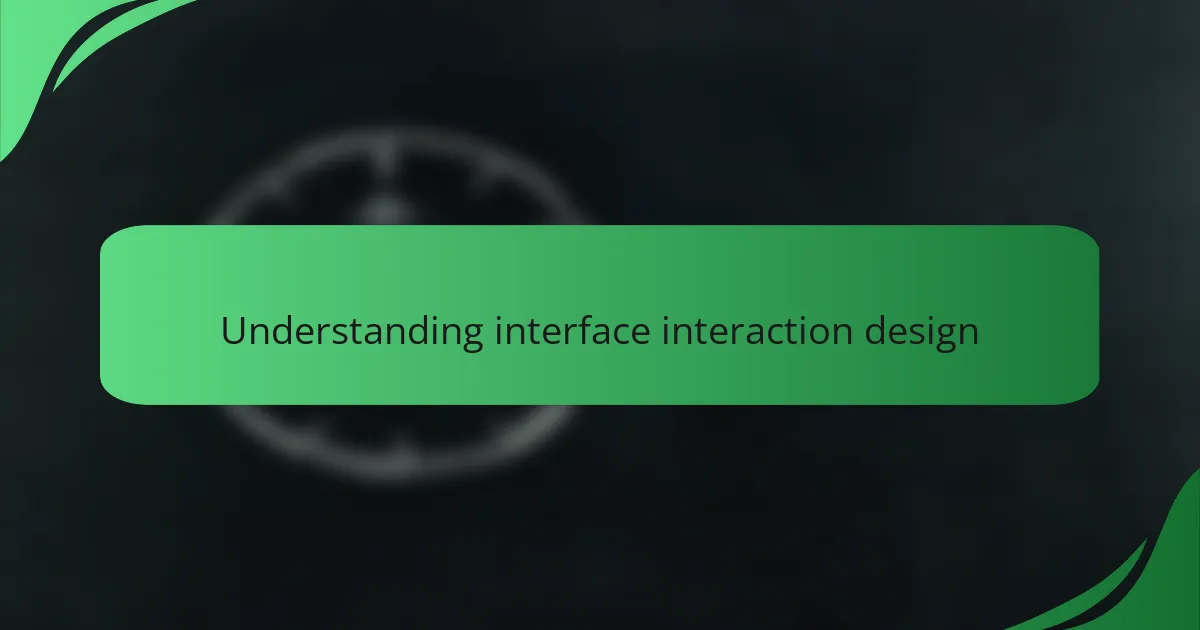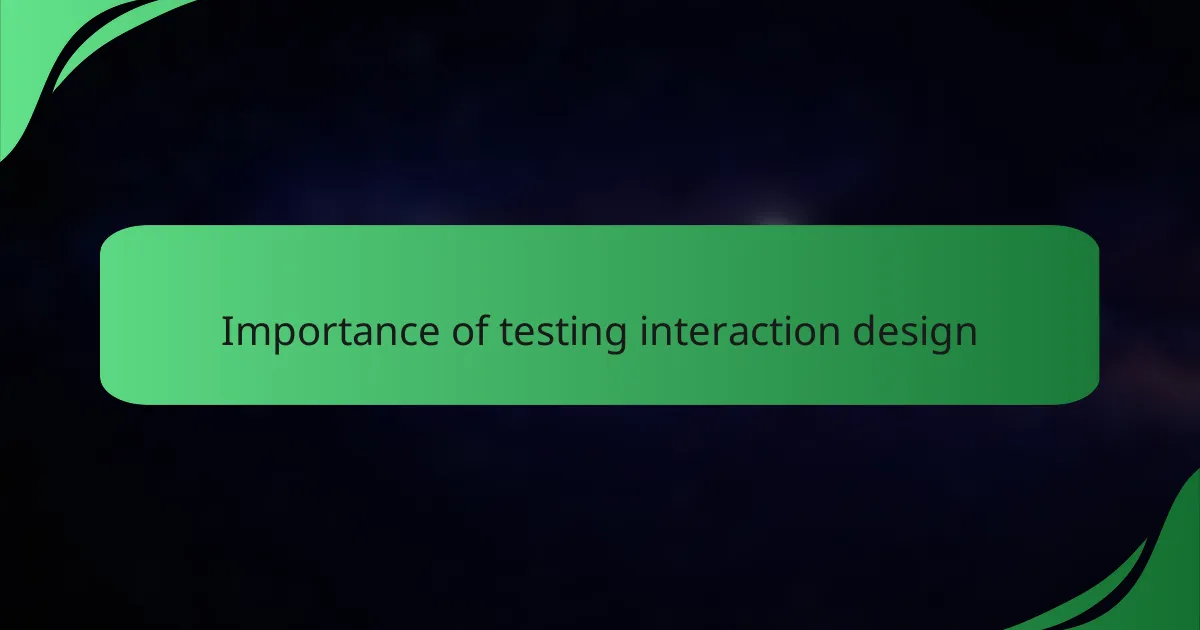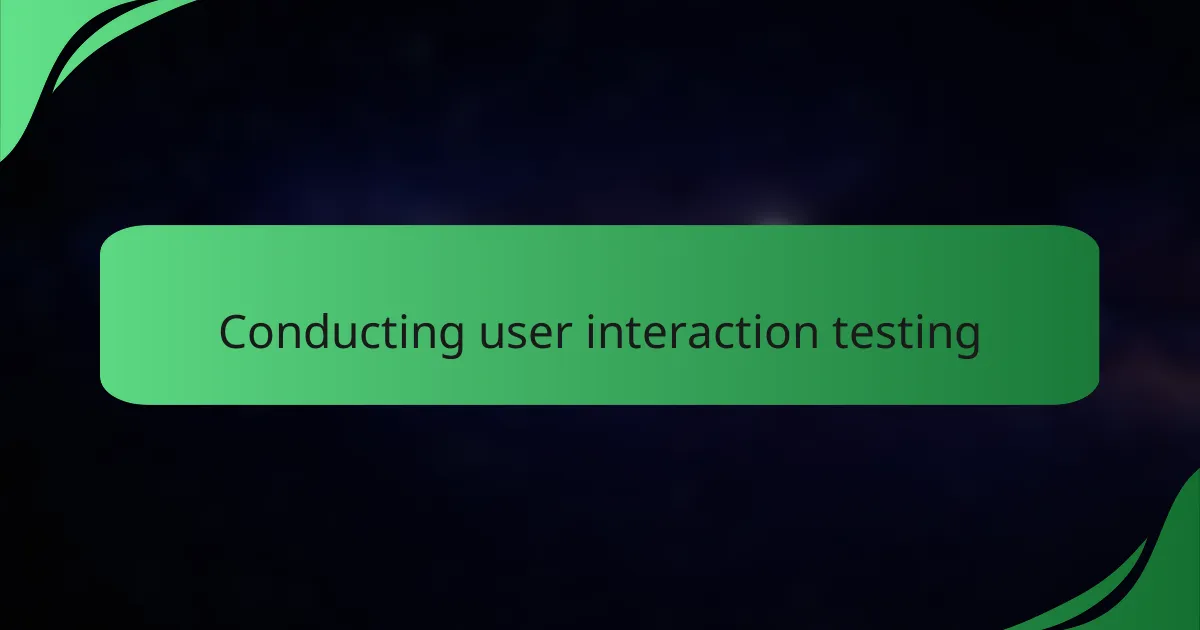Key takeaways
- Intuitive design is crucial for enhancing user engagement and creating a seamless experience across digital platforms.
- User testing reveals valuable insights, identifying friction points and preferences that inform and improve design choices.
- Effective feedback mechanisms foster a sense of community and connection between users and designers, leading to greater satisfaction.
- Design simplicity, along with proactive feedback, significantly impacts user interaction and overall experience with an application.

Understanding interface interaction design
Understanding interface interaction design involves looking closely at how users interact with digital platforms. I’ve found that a good design doesn’t just facilitate tasks; it creates a seamless experience that feels intuitive. Each element should serve a purpose, enhancing user engagement without overwhelming them.
In my testing of the Marvel App, I encountered moments where the design either delighted or frustrated me, based on how well it anticipated my needs. Noticing how certain features could either simplify or complicate my workflow gave me deeper insight into the subtleties of interaction design.
| Aspect | Marvel App |
|---|---|
| Intuitiveness | High, easy to navigate |
| Feature Accessibility | Good, some features require exploration |
| User Feedback | Incorporated but could improve |
| Overall Experience | Engaging and enjoyable |

Importance of testing interaction design
Testing interaction design is crucial because it directly impacts user experience. From my own experience, I’ve seen how small changes can significantly influence how users engage with an app. By testing, I could pinpoint friction points and enhance usability, leading to a more satisfying interaction overall.
When I experimented with the Marvel App, I realized that effective testing not only uncovers design flaws but also reveals user preferences that may not be immediately apparent. It’s like having a conversation with users; their feedback can be eye-opening and often brings unexpected insights, making the entire design process more user-centered.
In my journey, I also found that users appreciate when their voices are heard. Testing provides them a platform to express their thoughts, which fosters a stronger connection between the user and the app. That sense of involvement can transform a basic app into a beloved tool.
| Aspect | Importance of Testing |
|---|---|
| User Engagement | Enhances satisfaction by identifying pain points. |
| Performance Improvement | Uncovers areas needing optimization for better interaction. |
| User-Centered Design | Promotes a design that resonates with users’ needs and preferences. |

Overview of Marvel App features
Marvel App stands out for its user-friendly features that make design prototyping accessible and enjoyable. As I explored its capabilities, I was pleasantly surprised by how intuitive the interface felt, almost like I was discovering a new creative tool that sparked my imagination. Whether you’re a seasoned designer or just starting out, this app has something for everyone.
Here are some of the key features I found particularly useful:
- Prototyping: Create clickable prototypes that simulate user flows without any coding.
- Collaboration: Invite team members to comment in real-time, making feedback seamless and dynamic.
- Design Integration: Easily upload designs from popular tools like Sketch and Adobe XD.
- User Testing: Conduct usability tests right within the app, helping to refine designs based on actual user interactions.
- Feedback Tools: Gather insights and comments directly from users, which I found incredibly valuable for iterating on my designs.

Setting up tests with Marvel App
When it comes to setting up tests with Marvel App, I found it to be quite user-friendly. The initial steps involve uploading your design files and seamlessly integrating them into the platform. I remember the thrill of seeing my designs come to life in just a few clicks—it was almost like magic!
Next, I explored the interactive features, which allow for a hands-on approach to testing. What really stood out to me was how easy it was to invite team members and stakeholders to view and test the prototypes. The collaborative aspect made me feel more connected to the whole design process, allowing for immediate feedback.
Here’s a comparison of some key aspects of setting up tests in Marvel App:
| Feature | Description |
|---|---|
| File Upload | Drag and drop any design file for quick setup |
| Interactivity | Add interactive elements swiftly to enhance user experience |
| Team Collaboration | Invite team members for feedback right from the app |

Conducting user interaction testing
Conducting user interaction testing is an essential step in refining any application, and from my experience, it can be both illuminating and rewarding. When I engaged with the Marvel app, I focused on observing real users as they navigated through the interface. I found that their spontaneous reactions often revealed usability issues that I hadn’t anticipated, highlighting the importance of real-world testing.
One memorable moment was when a user struggled to find a specific feature that I thought was easy to access. Their frustration reminded me why user-centered design is crucial; it’s about ensuring that the interface resonates with users, not just with developers. This experience reinforced my belief that direct feedback is invaluable for creating an intuitive design.
Lastly, gathering quantitative data alongside qualitative observations allowed me to paint a clearer picture of how users interact with the app. It’s fascinating to see the numbers support or contradict personal observations, fostering a deeper understanding of user experience.
| Feedback Type | User Response |
|---|---|
| Interface Clarity | User found it confusing |
| Feature Accessibility | Struggled to locate |
| Overall Satisfaction | Mixed feelings |

Analyzing feedback from interactions
Understanding user feedback from interactions is like unlocking a treasure trove of insights. During my time testing the Marvel App, I noticed that the comments users provided often surprised me. For example, when a user mentioned they found a particular button confusing, it made me think about how my own assumptions about design might lead me astray. Their perspective, grounded in real use, highlighted the importance of looking beyond the design intentions and considering how users truly perceive the interface.
I also recall an instance when a user expressed excitement over an unexpected feature that simplified their workflow. Seeing their joy reaffirmed my belief that paying attention to user feedback can guide designers toward impactful improvements. It’s amazing how a single suggestion can shift the design focus to better meet user needs. I often find myself reflecting on the balance between intended simplicity and actual usability—how do we ensure that our well-designed features truly resonate with users?
In the end, analyzing the feedback wasn’t just about collecting data; it became a practice of listening deeply. Each comment, whether critical or positive, painted a richer picture of the user experience. I learned that engaging with users this way fosters a sense of community, making them feel valued and integral to the design process. Have you ever felt that your feedback transformed a tool you love? That sentiment is exactly what every designer should strive to create.

Lessons learned from using Marvel App
Using the Marvel App taught me several invaluable lessons about user interaction and design. First and foremost, I realized that the simplicity of navigation can significantly enhance user engagement. I remember the joy of effortlessly moving through the interface, which made me think: how often do we take for granted the ease of navigation in other apps? This experience emphasized for me that intuitive design is critical to holding users’ attention.
I also learned the importance of proactive user feedback in shaping effective design. During testing, one user mentioned a minor detail—like the position of a button—that turned out to be a major friction point. It struck me how a small oversight could lead to a frustrating experience, which made me question: how well do we, as designers, truly know our users? This incident opened my eyes to the fact that feedback is not just useful; it’s essential to evolving and improving a design.
Lastly, I found that each interaction speaks volumes about user preferences. When one user expressed delight over a feature that simplified their tasks, it warmed my heart and reaffirmed my commitment to user-centric design. That moment was a reminder of why we do what we do: to create tools that not only meet users’ needs but also bring them joy and satisfaction. Isn’t it incredible how one positive experience can shape the direction of your entire project?



